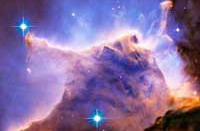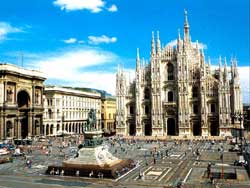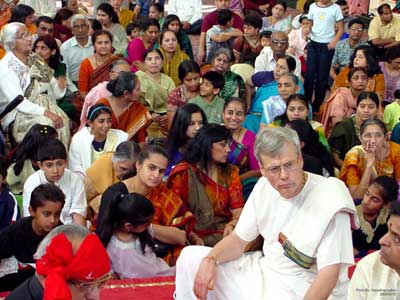 My plan for this week is to spend my time in the desert doing nothing, absolutely nothing. I will turn off my cell phone, I will close my email program, I will turn off my instant messages services and do nothing. Well, not exactly nothing. I plan to cleanse myself of rajas. I will strip off the layers of rajas that have accumulated over the last few months. Rajas is my greatest enemy; as it slowly builds it begins to consume me. Its symptoms include an inability to sleep soundly and to concentrate. I have become “peopled out.” I can no longer face another person or family and sincerely smile at them and give them the attention they deserve. I can no longer answer another email or schedule another puja. My cup is busting full. So now I will consciously shut down and allow myself a chance to recover. Thank God we are in the Hindu month of shraddha. (Shraddha is a two week period set aside to honor ancestors. Most pujas cease at this time.) I can use this time to “cool off.” I am only going to do the minimum in the temple. I will do no apartment construction and I will spend all my time here in the desert. Oh I love this place! I love the solitude. I love the huge views and the wide open space. I love the silence. I love the night time darkness. This is my place of meditation and prayer. These next two weeks I will become still.
My plan for this week is to spend my time in the desert doing nothing, absolutely nothing. I will turn off my cell phone, I will close my email program, I will turn off my instant messages services and do nothing. Well, not exactly nothing. I plan to cleanse myself of rajas. I will strip off the layers of rajas that have accumulated over the last few months. Rajas is my greatest enemy; as it slowly builds it begins to consume me. Its symptoms include an inability to sleep soundly and to concentrate. I have become “peopled out.” I can no longer face another person or family and sincerely smile at them and give them the attention they deserve. I can no longer answer another email or schedule another puja. My cup is busting full. So now I will consciously shut down and allow myself a chance to recover. Thank God we are in the Hindu month of shraddha. (Shraddha is a two week period set aside to honor ancestors. Most pujas cease at this time.) I can use this time to “cool off.” I am only going to do the minimum in the temple. I will do no apartment construction and I will spend all my time here in the desert. Oh I love this place! I love the solitude. I love the huge views and the wide open space. I love the silence. I love the night time darkness. This is my place of meditation and prayer. These next two weeks I will become still.
 I have previously mentioned “the cottage.” This cottage was originally the property of my maternal grandfather. It was during the 1950s that he leased the land on the banks of the Trent River and built his summer home. This was his getaway. Eventually my father assumed this property and used it as his getaway. There is little doubt that the reason I have my getaway property in the San Bernardino mountains of Southern California is the direct result of my upbringing. This is what the men of our family do. My bother, John, also has his cottage on a lake in northern Ontario. Everyone seems to go to water, but I have gone to the desert. A lot of building went on at this cottage so I grew up with building in my blood. It is not that I learned everything about construction at the cottage, instead I learned the possibilities. Framing, electrical, concrete, plumbing, dry walling, and painting skills are all a part of my early life. This cottage became an important part of my early life as it allowed me to grow up with the spirit of the rural life.
I have previously mentioned “the cottage.” This cottage was originally the property of my maternal grandfather. It was during the 1950s that he leased the land on the banks of the Trent River and built his summer home. This was his getaway. Eventually my father assumed this property and used it as his getaway. There is little doubt that the reason I have my getaway property in the San Bernardino mountains of Southern California is the direct result of my upbringing. This is what the men of our family do. My bother, John, also has his cottage on a lake in northern Ontario. Everyone seems to go to water, but I have gone to the desert. A lot of building went on at this cottage so I grew up with building in my blood. It is not that I learned everything about construction at the cottage, instead I learned the possibilities. Framing, electrical, concrete, plumbing, dry walling, and painting skills are all a part of my early life. This cottage became an important part of my early life as it allowed me to grow up with the spirit of the rural life.
On matters of religion and faith, I teach a lot of people, especially children. This is what I tell them: Personally, I have never seen God nor have I seen the soul. I can not prove the existence of God or the soul. Whether you choose to believe in God or whether you choose deny a God is a matter of personal faith. You either have that faith or you do not. But I tell my students that my faith is grounded on the sense of wonder that I feel about the world that I live in.
When I look out over the Pacific ocean and see the vastness of the sea, when I watch the sunset descending over the mountains and see the silver mist rising from the canyons, I am struck with a feeling of awe for the exquisite beauty of nature. That feeling of awe and reverence for the world is an aspect of God for me. Beauty is divine. When I look at pictures taken by the Hubble Space Telescope, I am confronted by the extreme vastness of space. Looking into a telescope is looking back into time! I see beauty, and again I am struck with wonder.
When I look into an electron microscope and see the extraordinary details of life at the molecular level, again I am struck by the extreme workings of creation. I see beauty. The complexity of life at the microcosm is divine.
And even as I watched the World Trade Centers collapsing on that fateful morning of September 11, 2001. I was struck by the awesome nature of so much death and destruction appearing before my eyes. That was negative beauty. I also saw that destruction as an aspect of the Divine. Aesthetics is the rationale for my faith.
As a father, I have seen birth, and as a priest I have watched death. Both are wondrous! Both suggest something amazing about life. So I ask, “What is that something”?
Anna, I cannot show you God or prove to you the existence of the soul. All I have is a sense of wonder for the awesome nature of life and death. Together this suggests there must be “a something”, an ordered foundation to life. That Something is what I call God. This is my leap of faith and it is based on my experiences in this world. Living with this kind of faith enriches my life, so I embrace it. A human reaches out and attempts to grasp hold of this Something, and through Its wonder and beauty this Something takes hold of the human heart. Religion is therefore a “dance” between this Something and the human heart. A human heart ignited is a most powerful thing. For better or worse religion brings out both the best and worst of humanity.
As a priest I stand on the edge of time, at the junction of the old and the new. On the one hand, I represent a tradition that goes back thousands of years with all its beauty, with all its superstitions, and with all its injustices. On the other hand, I get to pass on the best of this tradition to the children of this generation. I get to filter out what is no longer relevant. In my own way I nurture the faith of my students based on the reality of this world, and not because some book says there is a God or a soul. Faith properly developed can bring out the best of humanity. This kind of faith is indeed a sacred and wondrous thing.
*Image Sourcehttp://hubblesite.org/gallery/album/
Pope John Paul II was remembered Saturday as a “champion of human freedom,” a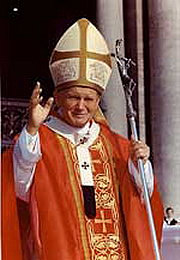 “tireless advocate of peace” and a man with a “wonderful sense of humor.” He died Saturday, aged 84, after a long battle with Parkinson’s disease and crippling arthritis. “We will always remember the humble, wise and fearless priest who became one of history’s great moral leaders.” This is the statement President Bush made regarding Pope John Paul II.
“tireless advocate of peace” and a man with a “wonderful sense of humor.” He died Saturday, aged 84, after a long battle with Parkinson’s disease and crippling arthritis. “We will always remember the humble, wise and fearless priest who became one of history’s great moral leaders.” This is the statement President Bush made regarding Pope John Paul II.
The passing of this pope has been huge story in the media. There has been 24 hour coverage. Without a doubt this pope touched the heart of many people. The media is already calling him Pope John Paul, The Great, and no doubt, he did many great things.
Yesterday, Tuesday April 19, 2005 a new pope, Benedict XVI, was elected. Again the media coverage was intense. The general perspective is that the previous pope was great and this new pope is ultra conservative. Only time will tell the real story. From my perspective I object to the media’s implication that the popes of Rome speak for all of humanity on matters of faith, ethics and morality. With the passing of John Paul II and the election of a new pope the issue of religious authority has come to my attention.
It is, of course, natural that during a time of loss and bereavement people will want to say and hear favorable things about a person, especially about a pope who reigned for so many years and truly did impact the life of many people. However, I remind myself that this past pope and his now successor stand for a 2000 year old religious tradition that is tainted with many wrongs in the name of what is supposed to be divine. The crusades, the inquisition and the churches dealing with science come to mind as a few examples.
The basic premise of Christianity is that the message of Christ is the true message of God, and the premise of Roman Catholicism is that the Church of Rome is the true arbiter of that message, even to the exclusion of other Christian faiths. Of course, this raises the issue of religious authority within a given religious tradition and between different religions. Most religions assert to some degree that their particular faith is the real truth and that other religions are either outright wrong or are only a partial manifestation of truth.
The past pope, John Paul II, has been credited as being open to other faiths. It is true that he forged alliances with other branches of Christians, that he was the first pope to pray in a mosque and that he opened a dialogue with Judaism. These are indeed liberal gestures, but let us not forget that it has taken his church 2000 years to come to this point. Hinduism and Buddhism have never had a problem acknowledging the validity of other faiths. And now that the Roman Church has opened its door of tolerance to other Christian faiths and even to Judaism and Islam, how far can it open its door to a non monotheistic faith, such as Hinduism or to a non theist faith such as Buddhism? Not much, believe me. This was seen when the pope visited India. He simply tried to convert as many Hindus to Roman Catholicism as he could. So I am not impressed by the liberality of this past pope or the Roman Catholic Church or of Christianity. And as far as his ability to speak for the morality of humanity, I would like to see the church accept the validity of my faith first before it presumes to speak for other aspects of my life. Roman Catholicism has barely embraced the rest of Christianity, so how can it embrace all of humanity?
*Source: http://www.vatican.va/news_services/or/photo/ph_index_ita.html
Snapshot by snapshot I am laying a foundation of understanding. Before you can comprehend the specifics of my life at this stage you need to know the philosophical and theological context of my life. So we discussed maya; I now want to discuss Hari Nama. I hope these small segments are palatable.
hope these small segments are palatable.
Another story: There was a sage named Hari Dasa. (Hari is a name for God and Dasa means servant, thus Hari Dasa means servant of God.”) Hari Dasa was actually a Muslim, but somehow he had become attracted to the Hindu deity, Krishna. In fact he was famous as a devotee of Krishna and used to sit alone in a cave and recite the names of Krishna. His vow was to chant 300,000 names of Krishna daily. This act of austerity took most of his day so he had just a few minutes to eat and bathe each day. The local king was a Muslim and when he heard that Hari Dasa was actually a Muslim, who was worshipping a Hindu god in his kingdom, he became incensed. He decided to ruin Hari Dasa. Of course we know the best way to bring down an ascetic, use a woman. So this muslim ruler employed the services of his most beautiful courtesan, Mayadevi. (Devi means goddess). Dressed in her most attractive outfit Mayadevi approached the cave where Hari Dasa lived. Unlike the sage Vishvamitra, Hari Dasa was wide awake and sitting outside of his cave chanting the names of Krishna on his beads. Hare Krishna, Hare Rama was his prayer over and over for hours on end.
When Mayadevi approached Hari Dasa he gave her a big smile and asked how he could serve her. Very sweetly she told him that she would like to make love to him and would he be agreeable? Hari Dasa was delighted to hear this proposal, but he said that he would first have to finish his daily routine of chanting. He asked Mayadevi to sit before him and wait. Mayadevi waited while Hari Dasa gently chanted his rounds aloud. Hours went by and it soon became too late to act on Mayadevi’s proposal, so Hari Dasa asked if she would come back the next day. For sure he would make love with her at that time. Mayadevi returned the next day and sat before Hari Dasa as he again chanted his rounds on his beads. Unfortunately it became late and they could not make love. This occurred on the third day as well.
Mayadevi waited while Hari Dasa gently chanted his rounds aloud. Hours went by and it soon became too late to act on Mayadevi’s proposal, so Hari Dasa asked if she would come back the next day. For sure he would make love with her at that time. Mayadevi returned the next day and sat before Hari Dasa as he again chanted his rounds on his beads. Unfortunately it became late and they could not make love. This occurred on the third day as well.
By the fourth day Mayadevi was beginning to experience a change of heart and started to chant the names of Krishna along with Hari Dasa. If fact the heart of Mayadevi was becoming overwhelmed with feeling of love for Krishna. Tears of joy erupted from her eyes. She was becoming a devotee of Krishna herself. In the end she revealed to Hari Dasa the reason for coming to meet him. Mayadevi herself became an ascetic and gave up her profession as a courtesan. The muslim king soon came down with leprosy due to his evil desires against Hari Dasa. So what is the strongest force in the world? It is not woman, but the names of God. Maya had been turned into a devotee. The master of maya is Krishna.
There was a time when if I looked up into the sky and saw the beauty of the sunset I told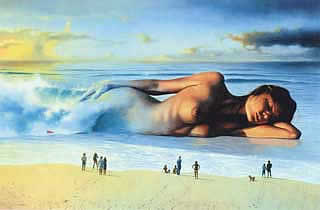 myself, “No don’t look. It is maya.” If is saw a beautiful moon rise, it was maya. If I felt affection for my children it was maya. If I enjoyed my favorite food it was maya. Maya was all a round me. Maya lurked in every corner of life. Maya was the enemy.
myself, “No don’t look. It is maya.” If is saw a beautiful moon rise, it was maya. If I felt affection for my children it was maya. If I enjoyed my favorite food it was maya. Maya was all a round me. Maya lurked in every corner of life. Maya was the enemy.
Maya is a Sanskrit word that means “trick” or “illusion.” Maya is said to be the power of God that creates illusion, and what is the most basic illusion? It is the illusion that makes one think I am this body, I am this man, I am this woman, I am Canadian, I am American, I am Russian. I am part of this world. In fact we are not of this world. Our real identity is that we are spiritual souls, we are not this body. It is only due to maya that we identify with our bodies, our gender, our nationalities and so on. Maya is the agency of God that binds us to this physical world. The veil of maya that covers our vision needs to be removed. When the ascetic is able to open his eyes and truly see the world free of maya he sees things as they truly are. Therefore, better not to see the world at all than to see it under the influence of maya. Close your eyes to the beauty of the physical world. Close your heart to the beauty of life. Open your soul only to God. The world is a trick of maya.
Why would God want to keep us in maya? Because we desire to enjoy this physical world and if we saw matter as it really is–lifeless and dull, without pleasure–we could not enjoy this world. Therefore, as long as we desire to enjoy this world we are kept shackled by maya, the illusion that we are a part of this world. The world is a prison-house for the soul and maya is the gatekeeper. And what is the strongest force of maya in this world? It is woman. Sex and love are the strongest binding forces in this world. Deny them.
*Jim Warren
At a recent temple board meeting one of our members made an interesting statement. This was during a discussion on the priest’s role in different temple meetings, some of which are held exclusively amongst ladies. This member said, “A priest is not a man. He can sit with the ladies for their meetings.”
This was during a discussion on the priest’s role in different temple meetings, some of which are held exclusively amongst ladies. This member said, “A priest is not a man. He can sit with the ladies for their meetings.”
“A priest is not a man?” I asked him. “Come talk to my wife about this.”
“Well you know what I mean. A priest is above all that,” he told me.
“Above all what?” I asked.
“You know, material things. A priest has no material needs. Right?” I just looked at him.
“Do you think my wife and nine children would allow me to come to work at this temple if I did not get paid?” The conversation ended at this point.
Anna, I find this member’s comments to be telling because they reflect many people’s view of religion and spirituality. They assume that religion and spirituality are necessarily separated from the world and therefore that religious and spiritual people are not of this world. Hence the conclusion that a priest has no material needs or a priest is neutered.
But what does it mean to be religious? What does it mean to be spiritual? Are the two the same? In my answer to Radhika’s question (see Outlook, Theology) I have defined religion as a combination of two components, faith and a resultant cumulative tradition. By faith I mean a feeling of trust that there is more to life than what simply meets the eye, that there is meaning and order and ultimately some kind of controlling force to life. By cumulative tradition I mean the sacred texts, the beliefs, the architecture, the art, the music, the dietary laws, the social system, the dress codes, and everything else that results from the collective faith of those who adhere to this form of faith. A religious person, therefore, is a person of faith who has committed himself to live within the bounds of a particular cumulative religious tradition. A person who is merely spiritual is also a person of faith, but at the same time is a person who is not committed to a particular cumulative religious tradition. We could perhaps call such a person a “freelance” truth seeker. A religious person is also a truth seeker, but with the difference that this person is committed to the truth of a particular religious tradition. A person who is merely spiritual claims allegiance to no cumulative religious tradition and therefore may randomly pick and choose various practices and beliefs from the world’s cumulative religious traditions, something from Buddhism, something from Islam, something from Hinduism, something from Christianity, and so on. This happens a lot in modern culture as many people reject traditional religions. Personally I do not recommend such an approach for there is a great merit in adhering to a cumulative tradition. It provides discipline and structure.
Even I have stated that I have become less religious and more spiritual over the years. By this I mean that I find myself less committed to a particular cumulative religious tradition and therefore I am more willing to jettison parts of the cumulative tradition when parts interfere with basic spiritual truths. I view the underlying faith as more important than the rules, rituals and beliefs, etc. In my early days I viewed my religion as an absolute manifestation of truth, now I see it merely as a vehicle of truth and so I am willing to treat it as secondary. It is natural that one eventually comes to the point of transcending one’s cumulative tradition and I have come to that point.
There are primarily two factors that have led to this shift of views. First and foremost is my academic background, particularly from my studies of comparative religion. It is simply impossible to maintain an absolutist’s position after studying the cumulative religious traditions of many religions. A study of this kind forces one to accept the relative nature of a religious culture. Second, in my life as a priest, I have come to understand the relativistic nature of religious culture. In working with a large congregation, a priest is constantly confronted with an endless variety of personal expressions of faith, from the most sophisticated and lofty to the most crude and superstitious. A priest continually has to modify the cumulative tradition to suit the needs of the individual or a given situation. So a priest soon comes to realize the non absolute nature of the cumulative tradition. I will always jettison tradition in favor of what best nurtures faith. I have learned that it is the underlying faith that is paramount and not the particular beliefs and practices. For me this has meant that even the basis for my own faith has shifted from scripture, which of course is a part of the cumulative religious tradition, and towards my internal “compass” of faith. Sacred writings are no longer absolute. They are a guide.
To return to the comments of our temple member who defined religion and spirituality in terms of other-worldliness. What our board member had in mind was a monk, an unmarried person, and a monk by definition is a person who is divorced from the world. Many religions indeed do have monks as priests, but many do not including Hinduism and there are many good reasons for this. Just look at the sexual scandals that have rocked the Roman Catholic Church for a vivid illustration. A priest with a spouse and a family necessarily has all the needs and concerns of the world and there is nothing inherently unspiritual about matter or the world. Everything depends on attitude.
My ‘shack’ is a tiny cottage nestled in the side of a hill facing the wilderness area on the edge of Riverside. Extending for a thousand feet in front of my home, there is a ravine that opens to the foot of three ancient volcanos.  These great giants have watched over this ravine for millennia. The sound of the city can never be heard from my shack. It is always silent and peaceful here. Overlooking my home are three glorious trees, two orange and a carob. To the right of my shack is a walnut tree which is only 6 years old, but in a decade, will rule as king. Tonight a friend has arrived. A tiny songbird is perched in one of the trees above my shack and every year, for the last ten years, this little bird arrives by mid-July and sings to his heart’s content every night starting at midnight. And so, for the first time this year, he is again offering his lullaby, that as I listen, puts me into a deep and restful sleep.
These great giants have watched over this ravine for millennia. The sound of the city can never be heard from my shack. It is always silent and peaceful here. Overlooking my home are three glorious trees, two orange and a carob. To the right of my shack is a walnut tree which is only 6 years old, but in a decade, will rule as king. Tonight a friend has arrived. A tiny songbird is perched in one of the trees above my shack and every year, for the last ten years, this little bird arrives by mid-July and sings to his heart’s content every night starting at midnight. And so, for the first time this year, he is again offering his lullaby, that as I listen, puts me into a deep and restful sleep.
Image taken from: http://ebird.org/content/ca/news/changes-in-california2019s-bird-communities-due-to-climate-change
I arrived in Milan by EuroStar train from the Italian east coast on Thursday evening and left by 9:00 AM Friday morning therefore my time in Milan was limited. However, my impressions of Milan are positive. I did some shopping on one of the major downtown streets and then traveled by subway to the Dumno. The Dumno area of Milan is spectacular. Unfortunately the whole facade was under renovation so I could not get a good view. The entrance ways into the square have been covered with vaulted glass to make an outstanding outdoor mall filled with trendy stores and restaurants. I dinned at one of these outdoor cafes. Milan is a city that I want to return to. It is clean safe and well organized and it felt exciting to be there. In all the places I visited throughout Italy I always found the Italian people to be warm, friendly and accommodating. Even in a big urbanized city like Milan I found this to be true. Milan was my last stop in Italy and it left me with good impressions of Italy.
There are places in this world that I call “mythological zones,” and by this, I mean places where the natural beauty of the land is so compelling and so overpowering that it opens pathways in my mind to an altered state of awareness. The island of Maui in Hawaii, Delphi and Santorini in Greece, and even my home in the high desert of Southern California are such places.
The ancient Sanskrit poet, Kalidasa, has a delightful poem in which a love- sick Yaksha, a kind of spirit being, is exiled to the mountains of southern India for neglecting his duty to his master, Kubera. In exile, this Yaksha yearns to be with his lover, and so he talks to the clouds and asks them to travel back to his home in the Himalayas and carry a message of love to his wife. Hence, the name of the poem, The Cloud Messenger. Kalidasa’s poem is an exquisite work that describes the beauty of nature and the inner feelings of this exiled Yaksha. Unfortunately, I had always thought of this poem, and other works of literature, as just something born from the fanciful imagination of its author. I did not take them seriously. Then one day, as I sat in a field on the island of Maui, in an environment similar to the Yaksha’s exile, I suddenly became overtaken by the beauty of this land, with its volcanoes and storm clouds, and its ocean and crashing surf. As I sat in this field, surrounded by green grass and wild flowers, I began to feel myself absorbed by this natural beauty.  Suddenly, as if the gods had opened their eyes and seen me, the world became “alive.” The grass “sang” for me and the flowers “smiled” at me; in effect I could “talk with the gods!” I had entered, what I call, for lack of a better term, a state of “wonder,” perhaps how a child sees the world; and at that moment I remembered Kalidasa’s poem and understood how his inspiration was possible. He must have been in his own state of wonder when he wrote The Cloud Messenger. It occurred to me that this creative state must be the source of a lot of literature and art, and even music.
Suddenly, as if the gods had opened their eyes and seen me, the world became “alive.” The grass “sang” for me and the flowers “smiled” at me; in effect I could “talk with the gods!” I had entered, what I call, for lack of a better term, a state of “wonder,” perhaps how a child sees the world; and at that moment I remembered Kalidasa’s poem and understood how his inspiration was possible. He must have been in his own state of wonder when he wrote The Cloud Messenger. It occurred to me that this creative state must be the source of a lot of literature and art, and even music.
Mostly I live in a “normal” state of awareness, but every so often, when the conditions are right, I slip into this special state, which I think is the source of creative genius. Had I not been forced to wait in Maui for a few extra hours (my flight to Los Angeles was not until late in the evening and my hotel room had expired), had I not veered off the regular road and found this quiet field, in other words, had I not left the tourist world, I surely would have missed seeing this magical side of Maui. Visitors come to this wonderful island from all over the world, and no doubt they appreciate its beauty and enjoy its delights, but I wonder how many of them step beyond the rational world of modern tourism and experience the Maui that I had seen, the mythological Maui. My vision in Maui had occurred purely by accident.
So I question whether there are ways to recreate this state at will. If the beauty of nature or even a Sanskrit poem can evoke a change of awareness, why not a painting, a sculpture, or even music? Why couldn’t all forms of art act as “doorways” to new states of awareness?
There is a song entitled Northern Lights by a contemporary music group, Enigma. What makes this song beautiful is that simply through sound, the music accurately depicts how the northern lights look and how they act. It is uncanny how perfectly this music represents these lights and how, just by hearing this music, it evokes the same state of awareness I experienced as a youth when I used to see these lights on a cold winter night in Canada. In those days I did not articulate my feelings as I am now, but seeing the lights effected a change of awareness, just like Maui, and at times the lights became so distinct and so powerful they put me in touch, so to speak, with the “aurora gods.” In other words, through this music, sound functions as a representation of the actual physical event, which in turn evokes the same change in awareness as the original event. So again I ask, if this can occur with music, then why not with paintings, sculpture, literature and other forms of art? After all, clouds and mountains and northern lights, or any other physical event, when reduced to their essence, is simply light entering the human brain through the eyes. Similarly, thunder or music is sound entering the brain through the ears, paintings are colors and textures on canvas that become light, and great works of literature are just dots on paper or pixels on a computer screen that also become light that enter the brain through the ears. Essentially all of these things are input into the human brain through the senses. Ultimately it is the human mind that processes this information and makes the determination, “This is beauty,” “This is art,” “This makes me feel creative.”
But not all vistas of nature, not all literature, not all paintings, and not all music evoke the same changes of consciousness in everyone. One person’s art is another person’s non art. The perception of beauty and the change of awareness that art can induce is highly subjective. How I respond to Maui or the northern lights is conditioned by who I am. Had I not seen the aurora borealis as a youth, I may not have responded to the music in the way I did. Had I not grown up with an appreciation of pristine wilderness, seeing it in northern Canada, I may not have been receptive to the pristine tropical wilderness of Maui.
And yet certain natural vistas or pieces of art or literature or music are universally accepted as manifestation of beauty. These works of art, the Mona Lisa for example, or certain vistas of natural landscape, the Grand Canyon in Colorado, for example, transcend individual subjectivity and cultural boundaries and are accepted by people in general as universal manifestations of beauty. And yet, these things can also be reduced simply to sensory input within the human brain. Ultimately, it is the human mind that responds to this input. Perhaps there are “universals,” archetypes, to use Jung’s terminology, within the human mind that respond to certain external “triggers,” and it is these triggers that we call the art. Perhaps good art somehow evokes or activates these universals; and the more precisely these universals are evoked, the more we judge the these triggers, the paint strokes, the colors, the sounds, the pixels, etc to be good art. What constitutes good art, therefore, is how precisely a particular painting, a piece of music, or a work of literature evokes these universals.
I wonder if it is possible to enter this creative state of awareness at will? Certainly travel to places like Maui or Delphi can induce this state, and certainly strong emotions, love or sadness, can induce this state. I know that dedication to a religious or political cause, or even certain drugs can open the mind to this state, but can art also function as a doorway into this creative mode of awareness? Of course the answer is yes. Unfortunately I used to think of art as just something “nice” to look at, but that it had little value beyond some form of artistic entertainment. I would often find myself in an art gallery filing passed the paintings one by one as if I was working through a check-list of items. Yet each one of these paintings took weeks, months and often years to produce. Each one is a reflection of the artist’s consciousness and creative perspective. I was missing so much by not understanding the power of art. I now think it is incumbent on me as a viewer to give more than just a “check-list” recognition to a serious work of art. This is not to suggest that I have to respond to every painting, every sculpture, every work of literature or score of music. Art remains subjective, but at least, for the pieces that I do choose to view, I now see the creative potential that is contained within each work. I now look at art in a new way and better understand the power of art to evoke this change in awareness.
So I wonder, if I go to galleries and take time to absorb in detail a few works of good art, if I fill my home with a few famous paintings, even as reproductions, if I listen to more good music, if I give myself an aesthetic education by studying art and music, in other words, if I fill my world with more art and beauty, could this have a positive influence on my ability to be more creative? Could I write my own version of Kali Dasa’s Cloud Messenger?
Image taken from: http://www.concierge.com/travelguide/maui/photos/photoview/54659

